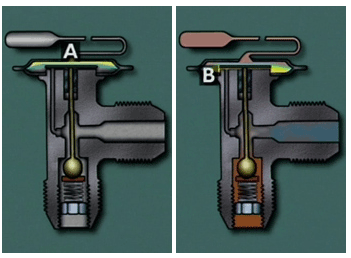How Do Thermal Expansion Valves Contribute to Enclosure Cooling?
 As new industrial technologies continue to develop, electrical components and devices such as variable frequency drives (VFDs) are getting more compact, creating more heat inside enclosures than ever before. Additionally, in order to save on installation costs, engineers and designers are increasingly forced to place electrical enclosures in harsh environments near heat producing machines or inoutside environmentswhere cabinet temperatures can exceed 130°F (54°C) from solar heat gain.
As new industrial technologies continue to develop, electrical components and devices such as variable frequency drives (VFDs) are getting more compact, creating more heat inside enclosures than ever before. Additionally, in order to save on installation costs, engineers and designers are increasingly forced to place electrical enclosures in harsh environments near heat producing machines or inoutside environmentswhere cabinet temperatures can exceed 130°F (54°C) from solar heat gain.
Unless components are properly cooled with an enclosure air conditioner equipped with a thermal expansion valve, excessive daily or seasonal temperature fluctuations can negatively impact sensitive electrical equipment. Safety and long term reliability may be jeopardized, leading to increased operating costs.
In order to provide continuous protection and longest possible life for your electrical components, a thermal expansion valve must be an integral part of the cooling system in order to keep your operation running trouble free.
Beneficial Functions a Thermal Expansion Valve Contributes to Enclosure Cooling
A thermal expansion valve (TXV) is a precision device designed to actively separate the air conditioning system into high pressure and low pressure sides. The most important function of the TXV is to regulate the flow of the high pressure liquid refrigerant into the evaporator coil. This process does two very important things that contribute to enclosure cooling:
- The thermal expansion valve provides maximum efficiency over wide range of ambient temperatures and loads. As a result the electrical components inside the enclosure will be safely maintained within a narrow ideal temperature range keeping them safe from overheating and imminent failure. By reducing the risk of failure costly production downtime can be avoided.
- The TXV also protects the compressor, which acts as the heart of an air conditioner, from potential damage. The refrigerant pressure drops as it passes through the TXV and on to the evaporator where a low pressure mixture of liquid and gas continues to vaporize as it absorbs heat from the system. The throttling effect of thermal expansion valve allows the evaporator to operate at maximum efficiency preventing excess liquid refrigerant from entering the return, or suction, side of the compressor.
The process of liquid returning to the compressor is often referred to as liquid slugging or flood-back, which can destroy a compressor. Not only is this costly in terms of air conditioner replacement, but can also result in overheated electrical equipment leading to failure and an unplanned plant shutdown.
In addition to keeping electrical equipment at a constant safe temperature and liquid from entering the compressor, a thermal expansion valve has the ability to rapidly adjust refrigerant flow if there are sudden changes in temperature. Also, a TXV will help maintain proper flow even if the system is over or under-charged with refrigerant.
Not All Enclosure Air Conditioners Are Created Equal
For better long-term performance and to help battle fluctuating ambient temperatures, selecting an air conditioner equipped with a thermal expansion valve is a must. This can save money in the long run by extending the life and reliability of your electrical components and reducing air conditioner maintenance costs.
For this reason, all Thermal-Edge enclosure air conditioners are equipped with a thermal expansion valve to ensure your electrical equipment is continuously protected. To learn more about how thermal expansion valves can help protect your valuable equipment contact the experts at Thermal-Edge today.


